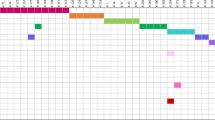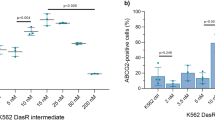Abstract
Early assessment of response at 3 months of tyrosine kinase inhibitor treatment has become an important tool to predict favorable outcome. We sought to investigate the impact of relative changes of BCR-ABL transcript levels within the initial 3 months of therapy. In order to achieve accurate data for high BCR-ABL levels at diagnosis, beta glucuronidase (GUS) was used as a reference gene. Within the German CML-Study IV, samples of 408 imatinib-treated patients were available in a single laboratory for both times, diagnosis and 3 months on treatment. In total, 301 of these were treatment-naïve at sample collection. Results: (i) with regard to absolute transcript levels at diagnosis, no predictive cutoff could be identified; (ii) at 3 months, an individual reduction of BCR-ABL transcripts to the 0.35-fold of baseline level (0.46-log reduction, that is, roughly half-log) separated best (high risk: 16% of patients, 5-year overall survival (OS) 83% vs 98%, hazard ratio (HR) 6.3, P=0.001); (iii) at 3 months, a 6% BCR-ABLIS cutoff derived from BCR-ABL/GUS yielded a good and sensitive discrimination (high risk: 22% of patients, 5-year OS 85% vs 98%, HR 6.1, P=0.002). Patients at risk of disease progression can be identified precisely by the lack of a half-log reduction of BCR-ABL transcripts at 3 months.
This is a preview of subscription content, access via your institution
Access options
Subscribe to this journal
Receive 12 print issues and online access
$259.00 per year
only $21.58 per issue
Buy this article
- Purchase on Springer Link
- Instant access to full article PDF
Prices may be subject to local taxes which are calculated during checkout




Similar content being viewed by others
References
Hehlmann R, Hochhaus A, Baccarani M, European L . Chronic myeloid leukaemia. Lancet 2007; 370: 342–350.
Baccarani M, Cortes J, Pane F, Niederwieser D, Saglio G, Apperley J et al. Chronic myeloid leukemia: an update of concepts and management recommendations of European LeukemiaNet. J Clin Oncol 2009; 27: 6041–6051.
Hanfstein B, Müller MC, Hehlmann R, Erben P, Lauseker M, Fabarius A et al. Early molecular and cytogenetic response is predictive for long-term progression-free and overall survival in chronic myeloid leukemia (CML). Leukemia 2012; 26: 2096–2102.
Deininger M, O'Brien SG, Guilhot F, Goldman JM, Hochhaus A, Hughes TP et al. International randomized study of interferon vs STI571 (IRIS) 8-year follow up: sustained survival and low risk for progression or events in patients with newly diagnosed chronic myeloid leukemia in chronic phase (CML-CP) treated with imatinib. ASH Annual Meeting Abstracts 2009; 114: 1126.
Hochhaus A, Erben P, Ernst T, Mueller MC . Resistance to targeted therapy in chronic myelogenous leukemia. Semin Hematol 2007; 44 (Suppl 1): S15–S24.
Cortes J, Hochhaus A, Hughes T, Kantarjian H . Front-line and salvage therapies with tyrosine kinase inhibitors and other treatments in chronic myeloid leukemia. J Clin Oncol 2011; 29: 524–531.
Saussele S, Lauseker M, Gratwohl A, Beelen DW, Bunjes D, Schwerdtfeger R et al. Allogeneic hematopoietic stem cell transplantation (allo SCT) for chronic myeloid leukemia in the imatinib era: evaluation of its impact within a subgroup of the randomized German CML Study IV. Blood 2010; 115: 1880–1885.
Sokal JE, Cox EB, Baccarani M, Tura S, Gomez GA, Robertson JE et al. Prognostic discrimination in "good-risk" chronic granulocytic leukemia. Blood 1984; 63: 789–799.
Hasford J, Pfirrmann M, Hehlmann R, Allan NC, Baccarani M, Kluin-Nelemans JC et al. A new prognostic score for survival of patients with chronic myeloid leukemia treated with interferon alfa. Writing Committee for the Collaborative CML Prognostic Factors Project Group. J Natl Cancer Inst 1998; 90: 850–858.
Hasford J, Baccarani M, Hoffmann V, Guilhot J, Saussele S, Rosti G et al. Predicting complete cytogenetic response and subsequent progression-free survival in 2060 patients with CML on imatinib treatment: the EUTOS score. Blood 2011; 118: 686–692.
Baccarani M, Deininger MW, Rosti G, Hochhaus A, Soverini S, Apperley JF et al. European LeukemiaNet recommendations for the management of chronic myeloid leukemia: 2013. Blood 2013; 122: 872–884.
Marin D, Milojkovic D, Olavarria E, Khorashad JS, de Lavallade H, Reid AG et al. European LeukemiaNet criteria for failure or suboptimal response reliably identify patients with CML in early chronic phase treated with imatinib whose eventual outcome is poor. Blood 2008; 112: 4437–4444.
Druker BJ, Guilhot F, O'Brien SG, Gathmann I, Kantarjian H, Gattermann N et al. Five-year follow-up of patients receiving imatinib for chronic myeloid leukemia. N Engl J Med 2006; 355: 2408–2417.
Hehlmann R, Lauseker M, Jung-Munkwitz S, Leitner A, Müller MC, Pletsch N et al. Tolerability-adapted imatinib 800 mg/d versus 400mg/d versus 400mg/d plus interferon-alpha in newly diagnosed chronic myeloid leukemia. J Clin Oncol 2011; 29: 1634–1642.
Hughes TP, Hochhaus A, Branford S, Müller MC, Kaeda JS, Foroni L et al. Long-term prognostic significance of early molecular response to imatinib in newly diagnosed chronic myeloid leukemia: an analysis from the International Randomized Study of Interferon and STI571 (IRIS). Blood 2010; 116: 3758–3765.
Marin D, Ibrahim AR, Lucas C, Gerrard G, Wang L, Szydlo RM et al. Assessment of BCR-ABL1 transcript levels at 3 months is the only requirement for predicting outcome for patients with chronic myeloid leukemia treated with tyrosine kinase inhibitors. J Clin Oncol 2012; 30: 232–238.
Jabbour E, Kantarjian H, O'Brien S, Shan J, Quintas-Cardama A, Faderl S et al. The achievement of an early complete cytogenetic response is a major determinant for outcome in patients with early chronic phase chronic myeloid leukemia treated with tyrosine kinase inhibitors. Blood 2011; 118: 4541–4546.
Müller MC, Cross NC, Erben P, Schenk T, Hanfstein B, Ernst T et al. Harmonization of molecular monitoring of CML therapy in Europe. Leukemia 2009; 23: 1957–1963.
Hughes T, Deininger M, Hochhaus A, Branford S, Radich J, Kaeda J et al. Monitoring CML patients responding to treatment with tyrosine kinase inhibitors: review and recommendations for harmonizing current methodology for detecting BCR-ABL transcripts and kinase domain mutations and for expressing results. Blood 2006; 108: 28–37.
Emig M, Saussele S, Wittor H, Weisser A, Reiter A, Willer A et al. Accurate and rapid analysis of residual disease in patients with CML using specific fluorescent hybridization probes for real time quantitative RT-PCR. Leukemia 1999; 13: 1825–1832.
Cross NC . Standardisation of molecular monitoring for chronic myeloid leukaemia. Best Pract Res Clin Haematol 2009; 22: 355–365.
Anderson JR, Cain KC, Gelber RD . Analysis of survival by tumor response. J Clin Oncol 1983; 1: 710–719.
Pfirrmann M, Hochhaus A, Lauseker M, Saussele S, Hehlmann R, Hasford J . Recommendations to meet statistical challenges arising from endpoints beyond overall survival in clinical trials on chronic myeloid leukemia. Leukemia 2011; 25: 1433–1438.
Vigneri PG, Stagno F, Stella S, Cupri A, Forte S, Massimino M et al. High BCR-ABL levels at diagnosis are associated with unfavorable responses to imatinib mesylate. ASH Annual Meeting Abstracts 2012; 120: 2790.
Author information
Authors and Affiliations
Consortia
Corresponding author
Ethics declarations
Competing interests
The CML-Study IV is supported by the Deutsche Krebshilfe (Nr. 106642), Novartis, Nürnberg, Germany, Kompetenznetz für Akute and Chronische Leukämien (BMBF 01GI0270), José-Carreras Leukämiestiftung (DJCLS H09/01f, H06/04v, H03/01) and the European LeukemiaNet (LSHC-CT-2004-503216). SS declares employment and equity ownership. The remaining authors declare no conflict of interest.
Additional information
Supplementary Information accompanies this paper on the Leukemia website
Supplementary information
Rights and permissions
About this article
Cite this article
Hanfstein, B., Shlyakhto, V., Lauseker, M. et al. Velocity of early BCR-ABL transcript elimination as an optimized predictor of outcome in chronic myeloid leukemia (CML) patients in chronic phase on treatment with imatinib. Leukemia 28, 1988–1992 (2014). https://doi.org/10.1038/leu.2014.153
Received:
Revised:
Accepted:
Published:
Issue Date:
DOI: https://doi.org/10.1038/leu.2014.153
This article is cited by
-
European LeukemiaNet laboratory recommendations for the diagnosis and management of chronic myeloid leukemia
Leukemia (2023)
-
Adverse outcomes for chronic myeloid leukemia patients with splenomegaly and low in vivo kinase inhibition on imatinib
Blood Cancer Journal (2023)
-
A multicenter real-world evidence study in the Swiss treatment landscape of chronic myeloid leukemia
BMC Cancer (2022)
-
Discontinuation of Tyrosine Kinase Inhibitors in Patients with Chronic Myeloid Leukemia: a Review of the Biological Factors Associated with Treatment-Free Remission
Current Oncology Reports (2022)
-
Impact of BCR::ABL1 transcript type on RT-qPCR amplification performance and molecular response to therapy
Leukemia (2022)



